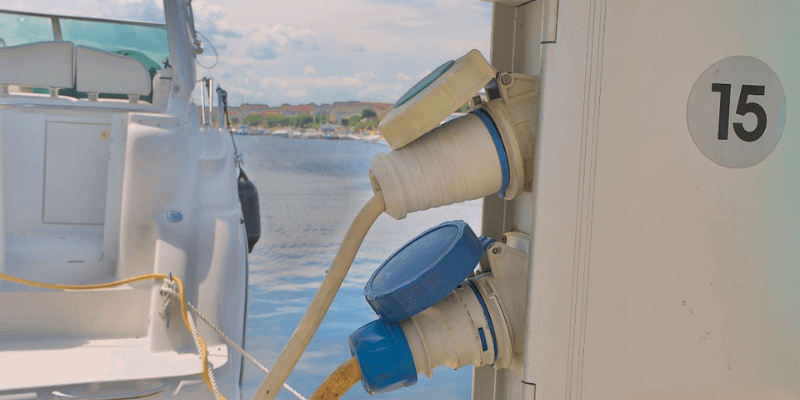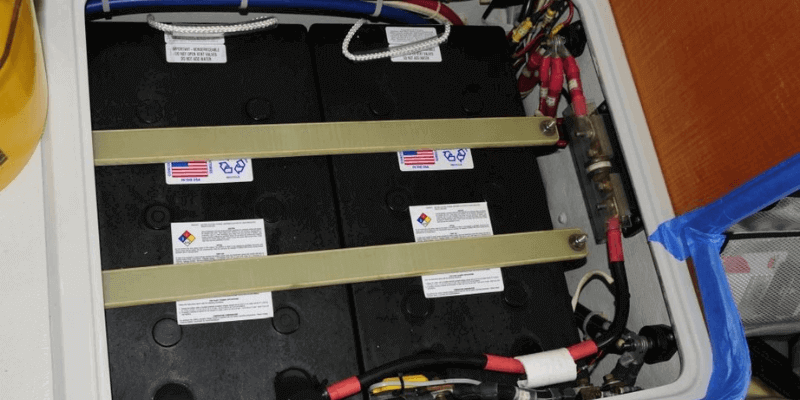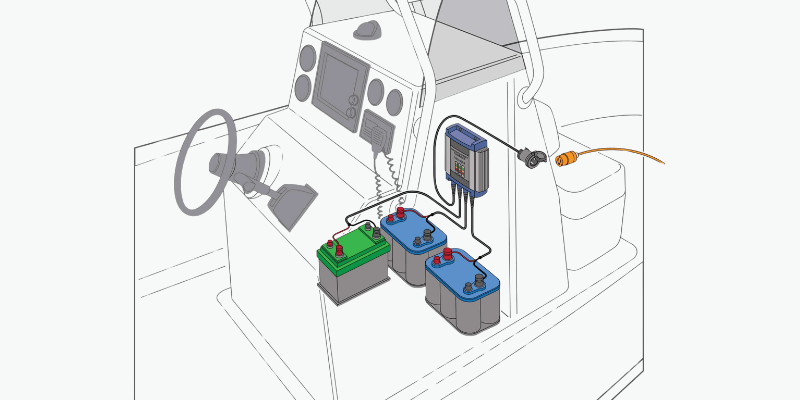Încărcarea bateriei marine este esențială pentru o experiență de navigație fără griji. Acest ghid acoperă tipurile de încărcătoare de baterii marine, aplicațiile lor și compatibilitatea cu bateria. Vă recomandăm să ne citiți blog pe bazele bateriei marine înainte de a explora încărcarea.
Care sunt tipurile de încărcătoare de baterii marine?
Există două tipuri de încărcătoare de bărci: la bord și portabile. Boaterii aleg pe baza obiceiurilor lor, cu unii optând atât pentru o copie de rezervă, fie pentru flexibilitate. Alegerea depinde de factori precum tipul de navigație, frecvența de utilizare și bugetul.
Încărcătoare de baterii de la bord
Încărcătoarele de marină la bord sunt instalate permanent și conectate la sistemul electric al bărcii. Monitorizează automat starea bateriei și reglează rata de încărcare. Aceste încărcătoare sunt perfecte pentru cei care își folosesc bărcile în apropierea surselor de putere sau a marinelor, eliminând nevoia unui încărcător portabil.
Metodele de încărcare la bord includ:
- Shore Power Charging: Această metodă comună este utilizată atunci când barca dvs. este agățată la un port marin, folosind un încărcător de baterii marine conectat la o sursă de alimentare externă.
- Încărcare offshore: Această metodă, spre deosebire de încărcarea puterii de la țărm, folosește generatoare la bord sau surse alternative de energie pentru a încărca bateriile. Integrarea sistemelor de energie solară îmbunătățește sustenabilitatea și autosuficiența, ceea ce este vital pentru călătoriile pe distanțe lungi.
- Încărcarea alternatorului: În timp ce se află pe apă, alternatorul motorului încărcă bateriile prin generarea de energie electrică. Cu toate acestea, menține în primul rând încărcarea bateriei de pornire și este posibil să nu reîncărce complet o Baterie cu ciclu profund sau gestionați în mod eficient bateriile profund descărcate.

Încărcătoare portabile de baterii marine
Încărcătoarele marine portabile sunt compacte și versatile pentru încărcarea bateriilor atât la bord, cât și pe uscat. Acestea vin în modele manuale, automate și inteligente, care găzduiesc diferite tipuri de baterii.
Ideal pentru navigație atunci când este necesară flexibilitatea, aceste încărcătoare permit reîncărcarea de la puterea țărmului sau de marine. Pentru proprietarii de mai multe bărci sau închirieri, un singur încărcător adaptabil este convenabil. De asemenea, barcii conștienți de buget îi preferă pentru rentabilitate în comparație cu sistemele de bord.
Compatibilitatea încărcătorului
Încărcătorul dvs. trebuie să fie compatibil cu bateria dvs., fie la bord sau portabil.
Pentru o singură baterie, verificați tensiunea sa (de obicei etichetată, de exemplu, 12 volți pentru baterii marine) și asigurați -vă că încărcătorul dvs. se potrivește. Luați în considerare capacitatea în orele ampere (AH); Producția unui încărcător ar trebui să fie de 10-20% din această capacitate. De exemplu, o baterie de 100ah are nevoie de un încărcător cu o ieșire de 10-20 amperi.
Adăugarea unei alte baterii complică încărcarea în funcție de modul în care acestea sunt conectate: în serie sau paralel. În serie, se adaugă tensiuni; Două baterii de 12 volți creează 24 de volți, necesitând un încărcător de 24 de volți. În paralel, tensiunea rămâne constantă, dar capacitatea se dublează; Două baterii de 12 volți asigură dublul capacității, menținând în același timp 12 volți. Folosiți un încărcător care poate gestiona nevoile combinate de amperaj – Dacă aveți două baterii de 100ah în paralel, selectați una care se poate încărca până la 200AH în mod eficient. Puteți obține mai multe informații despre conectarea bateriilor în serie și paralel Aici.

Care este importanța încărcării pe mai multe etape?
Încărcătoarele inteligente sunt potrivite pentru uz marin datorită tehnologiei lor și necesității menținerii bateriilor sănătoase. Atât versiunile portabile, cât și cele de la bord oferă capacități de încărcare inteligente care optimizează încărcarea eficientă și sigură a bateriei.
Spre deosebire de încărcătoarele tradiționale, încărcătoarele inteligente folosesc o abordare pe mai multe etape – Vrac, absorbția și plutirea pentru a accelera încărcarea, asigurând în același timp longevitatea bateriei. Această metodă împiedică supraîncărcarea prin reducerea treptată a curentului pe măsură ce bateria se apropie de capacitate maximă.
În mediul marin solicitant, în care o putere fiabilă este importantă pentru navigație și electronică, încărcătoarele inteligente îmbunătățesc siguranța și prelungesc durata de viață a bateriei, ceea ce le face o investiție valoroasă pentru proprietarii de bărci.
Ciclu profund AGM vs litiu
Încărcarea bateriilor marine AGM cu ciclu profund diferă de încărcarea bateriilor de litiu din cauza compozițiilor lor chimice. Bateriile cu plumb cu ciclu profund necesită un proces în mai multe etape – vrac, absorbție și plutitor pentru o performanță optimă; Încărcarea necorespunzătoare poate reduce semnificativ durata de viață.
În schimb, bateriile marine de litiu prezintă sisteme de gestionare a gestionării care împiedică supraîncărcarea și supraîncălzirea. Acestea pot gestiona rate mai mari de încărcare și descărcare și pot oferi o încărcare mai rapidă decât bateriile tradiționale cu ciclu profund.

Sfaturi de încărcare
După ce ați identificat încărcătorul de care aveți nevoie, urmați aceste cele mai bune practici pentru încărcarea marină:
Evitați supraîncărcarea: utilizați încărcătoare inteligente care monitorizează condițiile bateriei și reglați încărcarea pentru a preveni deteriorarea.
Mențineți o încărcare completă: mențineți bateriile complet încărcate pentru a evita sulfarea, în special în bateriile cu plumb-acid. Bateriile de litiu sunt mai puțin afectate de sarcinile parțiale.
Întreținere regulată: Verificați nivelurile de încărcare, nivelurile de electroliți (pentru baterii inundate) și conexiuni terminale. Curățați terminalele corodate și asigurați -vă că sunt strânse.
Depozitare corectă: atunci când nu este utilizat, utilizați un întreținător de baterii sau un încărcător de trucuri. Depozitați bateriile într -un loc rece și uscat.
Urmați instrucțiunile producătorului: respectați orientările specifice tipului de baterie.
Alegeți între încărcătoarele marine de bord sau portabile pe baza obiceiurilor dvs. de navigație. Încărcătoarele de bord oferă comoditate, în timp ce cele portabile oferă versatilitate. Asigurați -vă compatibilitatea prin potrivirea tensiunii, capacității și caracteristicilor cu bateria.
Urmând aceste orientări, veți menține o sursă de putere fiabilă pentru aventurile dvs. de navigație.

